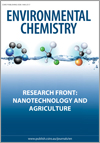
Environmental Chemistry
Volume 16 Number 6 2019
RESEARCH FRONT: Nanotechnology and Agriculture
EN19063Impact of iron and manganese nano-metal-oxides on contaminant interaction and fortification potential in agricultural systems – a review
Environmental context. Nanominerals are more reactive than bulk minerals, a property that strongly influences the fate of nutrients and contaminants in soils and plants. This review discusses applications of Fe- and Mn-nano-oxides in agricultural systems and their potential to be used as fertiliser and contaminant adsorbents, while addressing potential phytotoxicity. We discuss areas where significant advances are needed, and provide a framework for future work.
Environmental context. Bioaccumulation of nanoparticles in plants used for food and feed could be a major exposure pathway to nanoparticles, resulting in ecological and health risks. Isotopic labelling of nanoparticles enables their sensitive tracing in the presence of background elements in complex plant matrices. We investigate nine individual cases of plant–NP interactions and show the role of plants in the uptake and translocation of nanoparticles or their dissolution into metals.
EN18279Impact of (nano)formulations on the distribution and wash-off of copper pesticides and fertilisers applied on citrus leaves
 , Divina Navarro, Rai S. Kookana, Jason K. Kirby, Swadeshmukul Santra, Ali Ozcan and Shervin Kabiri
, Divina Navarro, Rai S. Kookana, Jason K. Kirby, Swadeshmukul Santra, Ali Ozcan and Shervin Kabiri
Environmental context. There are great concerns around current wide usage of copper-based agrochemicals. We compare the fate of nano- and conventional forms of copper, in particular their resistance to wash-off by rain (rainfastness), following their application to citrus leaves. Results showing large differences between the formulations in the amount and forms of copper washed from the leaves provide essential information to optimise agrochemical efficacy while minimising the environmental impact.
Environmental context. Nanomaterials are being extensively researched for use as agrochemicals, and some commercial formulations containing nanomaterials are already on the market. Information on environmental fate and effects of nanomaterials, however, are largely based on laboratory-synthesised materials. This study questions whether data on trophic transfer of Cu from pure, laboratory-synthesised Cu(OH)2 nanomaterials can be used to predict trophic transfer of Cu from a complex commercial fungicide formulation containing Cu(OH)2 nanomaterials.
EN19061Copper toxicity to Folsomia candida in different soils: a comparison between nano and conventional formulations

Environmental context. Nanotechnology has great potential for managing agricultural plant disease. This study compares effects of various nano and conventional copper formulations on Collembola Folsomia candida, a model arthropod often used to test soil pollutants. Although toxicity varied between formulations, with a nanopesticide showing one of the highest toxicities, the differences were mainly due to the active copper compound rather than its nano formulation.
Environmental context. Nanotechnology has great potential to provide a wide variety of benefits in food production, especially for plant-derived foods. We present an overview of augmented photosynthesis and its underlying mechanisms in plants in response to engineered nanomaterials. The goal of the review is to promote the development and application of nanotechnology in sustainable agriculture to increase crop productivity while minimising environmental impact.
Environmental context. Cadmium contamination in paddy soil can lead to elevated cadmium concentrations in rice, potentially affecting millions of rice consumers worldwide. This study used nanoscale zerovalent iron to sequester cadmium from soil before using magnetic separation to retrieve cadmium-sorbed particles from the soil slurry. This approach hypothetically resulted in a 97 % reduction of cadmium levels in rice, rendering the rice safe for human consumption.
EN19019Investigating the foliar uptake of zinc from conventional and nano-formulations: a methodological study
 , Casey L. Doolette
, Casey L. Doolette  , Tom Cresswell
, Tom Cresswell  , Nicholas R. Howell
, Nicholas R. Howell  , Robert Aughterson
, Robert Aughterson  , Inna Karatchevtseva, Erica Donner
, Inna Karatchevtseva, Erica Donner  , Peter M. Kopittke
, Peter M. Kopittke  , Jan K. Schjoerring
, Jan K. Schjoerring  and Enzo Lombi
and Enzo Lombi 
Environmental context. Zinc, an essential micronutrient often applied to crops as a fertiliser, can be difficult to analyse in plants due to limitations of conventional techniques. Here, we use radiotracers and a non-destructive imaging technique to visualise how zinc applied as a nanofertiliser moves within wheat plants over time. This is an important step towards developing cost-effective fertilisers to help solve one of the world’s most widespread plant deficiencies.
EN19057Nanoformulations can significantly affect pesticide degradation and uptake by earthworms and plants
 and Jakub Hofman
and Jakub Hofman 
Environmental context. Nanopesticides are increasingly being developed for agricultural use, but knowledge concerning their environmental fate and effects is limited. This microcosm study brings new results about soil fate and bioaccumulation of polymeric or lipid nanoparticles carrying chlorpyrifos or tebuconazole. The nanoformulations significantly altered the fate and bioavailability of the pesticides in soil even under the real-world and complex conditions of microcosms.
EN19047Effects of carbonaceous nanomaterials on soil-grown soybeans under combined heat and insect stresses

Environmental context. Engineered nanomaterials have the potential to accumulate in agricultural soils where they may influence crop plants. There is, however, little information about how adverse environmental conditions may interact with nanomaterial effects on plants and plant-microbe interactions. We report the comparative effects of three carbonaceous nanomaterials on the growth, nodulation and foliar health of a globally important legume crop, soybean, under the combined stresses of high temperature and insect pests.



